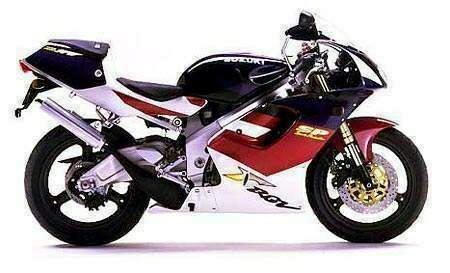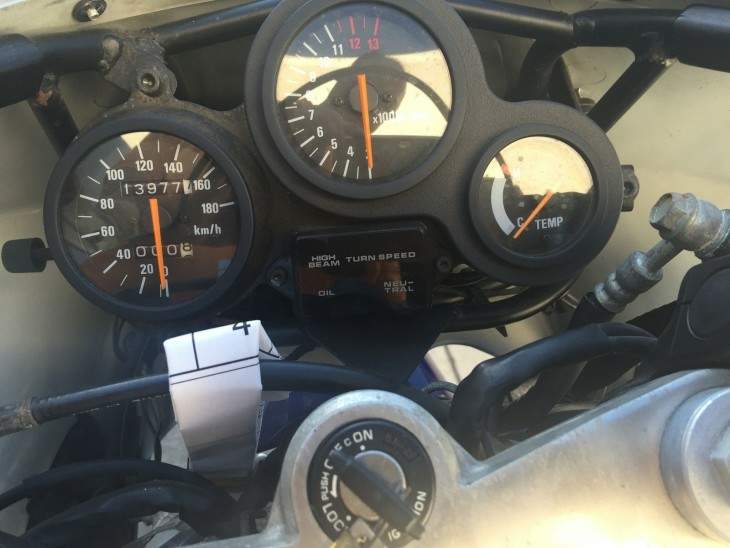
|
|
|
|
|
|
Classic Bikes
Custom Bikes
Individual
Racing Bikes AJP
AJS
Aprilia
Ariel
Avinton / Wakan
Bajaj
Benelli
Beta
Bimota
BMW
Brough Superior
BRP Cam-Am
BSA
Buell / EBR
Bultaco
Cagiva
Campagna
CCM
CF Moto
Combat Motors
Derbi
Deus
Ducati
Excelsior
GASGAS
Ghezzi Brian
Gilera
GIMA
Harley Davidson
Hero
Highland
Honda
Horex
Husaberg
Husqvarna
Hyosung
Indian
Jawa
Kawasaki
KTM
KYMCO
Laverda
Lazareth
Magni
Maico
Mash
Matchless
Mondial
Moto Guzzi
Moto Morini
MV Agusta
MZ / MuZ
NCR
Norton
NSU
Paton
Peugeot
Piaggio
Revival Cycles
Roland Sands
Royal Enfield
Sachs
Sherco
Sunbeam
Suzuki
SWM
SYM
Triumph
TVS
Ural
Velocette
Vespa
Victory
Vincent
VOR
Voxan
Vyrus
Walt Siegl
Walz
Wrenchmonkees
Wunderlich
XTR / Radical
Yamaha
Zero
Video
Technical
Complete Manufacturer List
|
Suzuki RGV 250 |
| . |
|
Model. |
Suzuki RGV 250 VJ23 |
|
Year |
1997 |
|
Engine |
Two stroke, 70° V- twin, reed valve with SAPC (Suzuki Advanced Power Controller) |
|
Capacity |
249 cc / 15.2 cu in |
| Bore x Stroke | 54 x 54.5 mm |
| Compression Ratio | NA |
| Cooling System | Liquid cooled |
|
Induction |
2 x Mikuni TM32SS semi-flat carburetors |
|
Ignition |
Pointless Electrical Ignition |
|
Spark Plug |
NGK BR9ES |
|
Battery |
12V, 5Ah |
|
Starting |
Kick & Electric |
|
Max Power |
39 hp / 29 kW @9500rpm T Mokel / 48 hp V Mokel |
|
Max Torque |
34.3 Nm / 25.3 lb.ft@8000rpm T Mokel |
|
Clutch |
Wet, multi-plate |
|
Transmission |
6 Speed, constant mesh |
|
Primary Reduction |
2.565 (59/23) |
|
Final Drive |
Chain, DID520V2, 114 links |
|
Frame |
Twin spar, aluminium |
|
Front Suspension |
41mm telescopic forks,Fully adjustable |
|
Front Wheel Travel |
120 mm / 4.7 in |
|
Rear Suspension |
Full Floater, mono-shock, gas/oil damped, 7-way adjustable |
|
Rear Wheel Travel |
140 mm / 5.5 in |
|
Front Brakes |
2 x 290 mm Discs ,4 piston calipers |
|
Rear Brakes |
Single 210 mm disc, 1 piston caliper |
|
Front Tyre |
110/70-17 |
|
Rear Tyre |
140/60-18 |
|
Rake |
25o |
|
Trail |
94 mm / 3.7 in |
|
Dimensions |
Length: 2015 mm / 79.3 in Width: 695 mm / 27.4 in Height: 1065 mm / 41.9 in |
|
Wheelbase |
1330mm / 52.4in |
|
Ground Clearance |
120 mm / 4.7 in |
|
Seat Height |
755 mm / 29.7 in |
|
Turning Radius |
3.1 m / 10.2 ft |
|
Lean Angle |
58° |
| Dry Weight | 134 kg / 295 lbs |
| Wet Weight | 161 kg / 355 lbs |
|
Fuel Capacity |
16 Litres / 4.2 US gal / 3.5 Imp gal |

Suzuki’s final incarnation of the RGV 250, the 1996 VJ23, was not only the finest of the line but also one of the finest two-strokes ever built. Rather than just knocking out a last-of-the-line edition based on its predecessors, the VJ23 got a total redesign from the engine out.
Where previous RGV’s were powered by a 90-degree two-stroke V-twin, the VJ23 got a 70-degree unit with a smaller bore and longer stroke giving it dimensions closer to square and more akin to the GP bikes than its greatly oversquare predecessor.
A close-ratio gearbox and dry clutch underlined the new model’s Sports Production tag.A kit gearbox with taller first and yet closer ratios was available too. Where previous RGVs had been kickstart the 23 got an electric start although there was no overall weight penalty for this given the extensive redesign work elsewhere. Chassis-wise, the VJ23 is as exquisite. Fully adjustable suspension and GP-inspired frame and swingarm are topped off with uncompromising bodywork. Not all VJ23’s were created equal and this is vital for a prospective buyer to know.
Production started some time prior to February 1996 with the first 50 bikes being built in this period; indeed the bike broke cover at the 1995 Tokyo Show. Bikes built up until late May 1996 were restricted to 40 bhp and known as the T model. All bar one, which was the prototype for the full-power 48 bhp V model, also known as the "export" model, ending in 1997.
In total just 2218 VJ23s were built with just 360 of those, plus the prototype, being the full-fat RGV 250V. A different CDI (go Zeeltronic rather than try to find a rare and expensive V box), a rejet and removal of the restrictor collars from the headers and airbox restrictor plate will get a T close to a V performance-wise.

|
Any corrections or more information on these motorcycles will be kindly appreciated. |